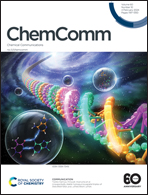Enriched switching in a donor–acceptor Stenhouse adduct via reversible covalent bonding†
Abstract
We have utilized reversible covalent bonding to expand the accessible states of a molecular switch. Introducing a hydroxyl group onto the donor moiety of a donor–acceptor Stenhouse adduct (DASA) imparts an acidity response by forming an oxazolidine ring through intramolecular nucleophilic addition. Furthermore, we observed distinct color changes under cryogenic conditions, extending the thermal responsiveness beyond the cyclization equilibrium observed at elevated temperatures. These unique responses present promising prospects for diverse applications compared to traditional photoinduced binary isomerization.



 Please wait while we load your content...
Please wait while we load your content...